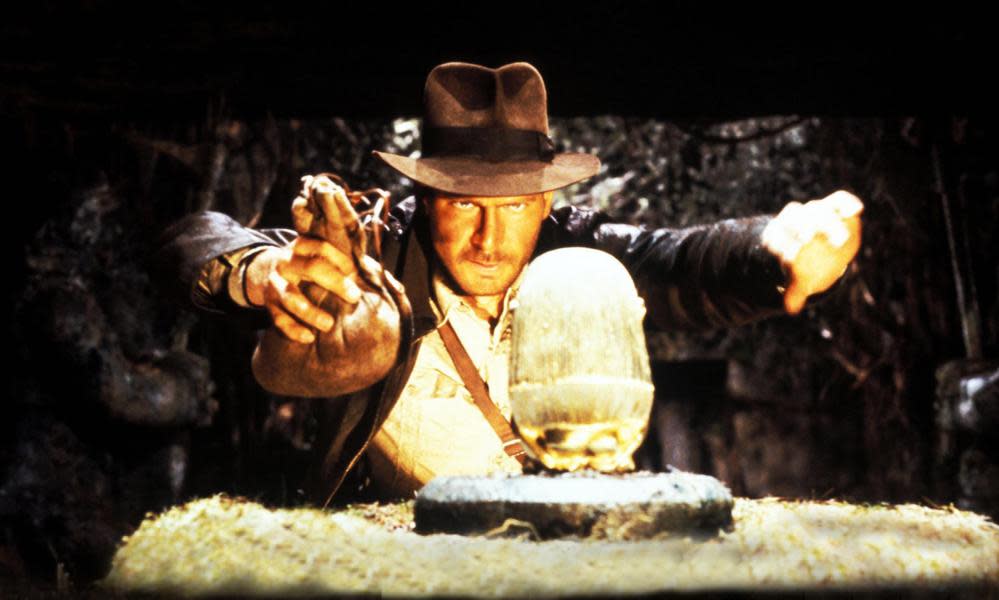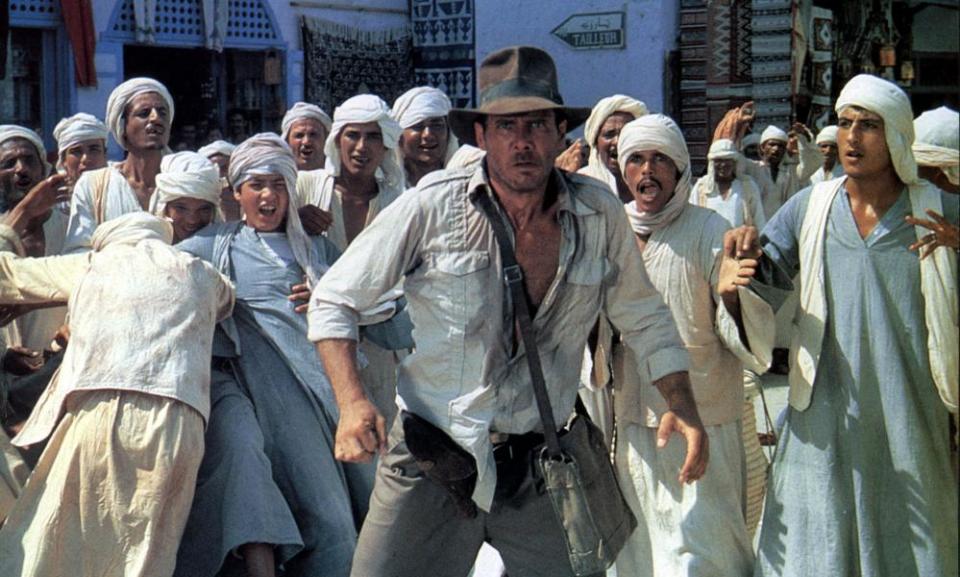Raiders of the Lost Ark at 40: Indiana Jones’s first adventure remains his greatest

It took almost no time – certainly not the 40 years since it was released – for Steven Spielberg’s Raiders of the Lost Ark to become the new standard of adventure films, surpassing the crude matinee serials that inspired it and shrewdly building on previous models like The Adventures of Robin Hood and John Huston/Humphrey Bogart team-ups The Treasure of the Sierra Madre and The African Queen. Its influence on the culture was immediate and widespread, most directly on knock-offs both skilled (Romancing the Stone) and not-so-skilled (Allan Quartermain and the Lost City of Gold), and across every commercial medium that could capitalize on it. (The Atari 2600 game Pitfall! was a personal favorite.)
Related: The Howling at 40: a horror movie that gave us something to chew on
Many more tombs have been raided in the decades since Raiders became a box-office phenomenon in 1981, including sequels of variously diminished returns, but none has recreated the same level of excitement and magic, and most have taken away the wrong lessons from it. The first lesson is “be Steven Spielberg”, which is understandably difficult for other film-makers to manage, since there can only be one director with his deft, seemingly intuitive feel for image-making and storytelling on a large scale. The second lesson is trickier, because attempting to replicate the bigness of Raiders – its globetrotting locales, its historical backdrop, its wall-to-wall action sequences – misses nearly everything that makes it great. As with all Spielberg films, the least expensive touches are the most significant.
Granted, a few of the more lasting images from Raiders cost a lot of money, like the bookends of Harrison Ford’s archaeological adventurer, Indiana Jones, outrunning a giant boulder in the first action sequence and the stop-motion face-melting of a Nazi super-villain as God punishes him for his hubris. But more often, Spielberg’s gift for lighting and framing, reaction shots and visual sleights-of-hand make the deepest impression: the opening dissolve from the Paramount logo to a South American mountaintop, the soft golden light emanating from a coveted idol, Indy’s unmistakable shadow darkening the doorway of his ex-lover’s bar in Nepal, the sunset silhouette of an archaeological dig in Cairo, the sly comedy of the villain’s medallion-scarred hand revealing itself with the “Sieg Heil” salute.
And on and on and on. As much as any Spielberg film before or since, Raiders of the Lost Ark is a pure exercise in style, an assemblage of can-you-top-this action set pieces held together by the thin tissue of old-fashioned romance and historical hokum. Of course, the hokum is of the highest quality – George Lucas and Philip Kaufman wrote the story, Lawrence Kasdan the sparkling dialogue – but the film feels in every way like Spielberg and friends creating the type of adventure they would have enjoyed as children, drawn from forgotten serials and comics, or treasured scenes from Only Angels Have Wings or Gunga Din or various sword-and-sandal epics. It’s the most sophisticated possible rendering of unsophisticated material, juvenilia done with peerless craft.
The quotation marks around the film, along with its boyish spirit, allow the audience to accept a cartoonish vision of the world (and of history) that would otherwise seem baldly xenophobic. From this perspective, Jones is not a ruthless plunderer of other country’s treasures, but a dashing intellect on a mission to unearth precious antiquities for public study. And the indigenous masses and sword-wielding goons who chase after him in South America and Cairo are of a type, too, that are abstracted from sources other than reality. (Still, the famous gag of a skilled Arab swordsman confronting Indy in the marketplace, only for our hero to casually blow him away, feels more than a little sinister in its implications.)
The Nazis certainly have it coming, however, as does Indy’s duplicitous French rival Belloq (Paul Freeman), who deploys the effective strategy of letting him do the hard work before taking his treasures away. Spielberg’s previous film, the calamitous action-comedy 1941, tried to wring the second world war for bawdy entertainment, and Raiders is a much more streamlined effort to do the same, as clean and satisfying as a punch square in a henchman’s jaw.

For the same director to make Schindler’s List 12 years later, replacing the cackling stereotype of a Gestapo agent with a Nazi camp lieutenant (Ralph Fiennes) of more multi-dimensional sadism, seems like an improbable evolution. But the two films do feel connected by the spiritual desecration of Nazism, here represented by a sacred prize, the Ark of the Covenant, that Hitler wants to deploy as a weapon of unimaginable occult power. By nature, Raiders allows itself to consider the war in the simplest possible terms, framing Nazism as a crime against God, as profane and hubristic and evil.
Watching God smite some Nazis is the capper to a film that’s wholly devoted to delighting its audience, without the complications of deeper themes and subtexts, much less psychological complexity. There are good guys and bad guys, locked in a mighty struggle to save or destroy the world. There’s a romance between Indy and his ex, the headstrong and hard-drinking Marion (Karen Allen), that seems copy-pasted from the frisky chemistry shared by Bogart and Katherine Hepburn in The African Queen. There’s the score by John Williams, with its unforgettable main theme held back until the moment Indy swings on his first vine.
And most of all, there’s Spielberg, maybe the greatest pure film-maker of his generation, at the peak of his powers, having to think about nothing more than orchestrating sequences with as much excitement and wit as he can muster. In its larger strokes, the film offers a clinic on suspense techniques, from the simple scene of Indy toying around with a date we know to be poisoned to the multi-planed action on the tarmac where he and Marion fend off Nazis while a gas leak inches closer to flame. But on repeat viewings, there are smaller details to savor, like the way dirt billows from Indy’s shirt as he crests a hill in the opening or the ground-level framing of him from behind a roused cobra after he drops into the Well of Souls.
Film history seems to be speaking through him in Raiders of the Lost Ark, which harnesses all he’s learned about westerns, swashbucklers, sword-and-sandal epics and war adventures. Forty years later, it’s still an education.

 Yahoo Movies
Yahoo Movies 
